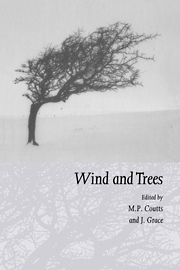Book contents
- Frontmatter
- Contents
- Preface
- List of contributors
- Part I Airflow over topography and in forests
- Part II Mechanics of trees under wind loading
- Part III Tree physiological responses
- 14 Wind-induced physiological and developmental responses in trees
- 15 Responses of young trees to wind: effects on root growth
- 16 Wind stability factors in tree selection: distribution of biomass within root systems of Sitka spruce clones
- 17 Development of buttresses in rainforest trees: the influence of mechanical stress
- Part IV Impacts of wind on forests and ecology
- Part V Risk assessment and management response
- Index
15 - Responses of young trees to wind: effects on root growth
Published online by Cambridge University Press: 27 October 2009
- Frontmatter
- Contents
- Preface
- List of contributors
- Part I Airflow over topography and in forests
- Part II Mechanics of trees under wind loading
- Part III Tree physiological responses
- 14 Wind-induced physiological and developmental responses in trees
- 15 Responses of young trees to wind: effects on root growth
- 16 Wind stability factors in tree selection: distribution of biomass within root systems of Sitka spruce clones
- 17 Development of buttresses in rainforest trees: the influence of mechanical stress
- Part IV Impacts of wind on forests and ecology
- Part V Risk assessment and management response
- Index
Summary
Abstract
Two experiments were carried out with Sitka spruce and European larch grown under intermittent wind in tunnels. In the first, both species were grown to determine whether there are any specific effects of wind on root growth, as opposed to effects on growth in general. In the second experiment, larch seedlings had their tap root removed 20 mm below the soil surface to mimic the formation of a shallow root plate, such as develops when larch is planted on seasonally waterlogged peat in much of the United Kingdom. In both experiments, lateral roots were counted and their orientation relative to the tap root recorded. In the wind-stressed trees in both experiments there was an increase of almost 60% in the number of large roots on the windward side of the trees and of 45% on the leeward side of larch trees compared with the number of roots growing at right angles to the direction of wind. In the first experiment, the sum of the cross-sectional area (Σ CSA) of lateral root bases was greater on the windward side of the tree compared with the other sides in both species. In the second experiment, Σ CSA of lateral root bases of wind-stressed larches was greatest on the leeward side whereas the control plants had a larger Σ CSA in the regions perpendicular to the wind direction. It appears that wind action stimulates the diameter growth of those roots most important for anchorage, but has a smaller effect on root development than other factors such as uneven nutrient supply.
- Type
- Chapter
- Information
- Wind and Trees , pp. 264 - 275Publisher: Cambridge University PressPrint publication year: 1995
- 18
- Cited by



